This Sourdough Starter is pretty darn easy to do and a great option for delicious homemade baked goods! A sourdough starter doesn’t have to be a chore, and the end result is worth the patience in the beginning. If you like homemade treats try my Sourdough Pretzels!
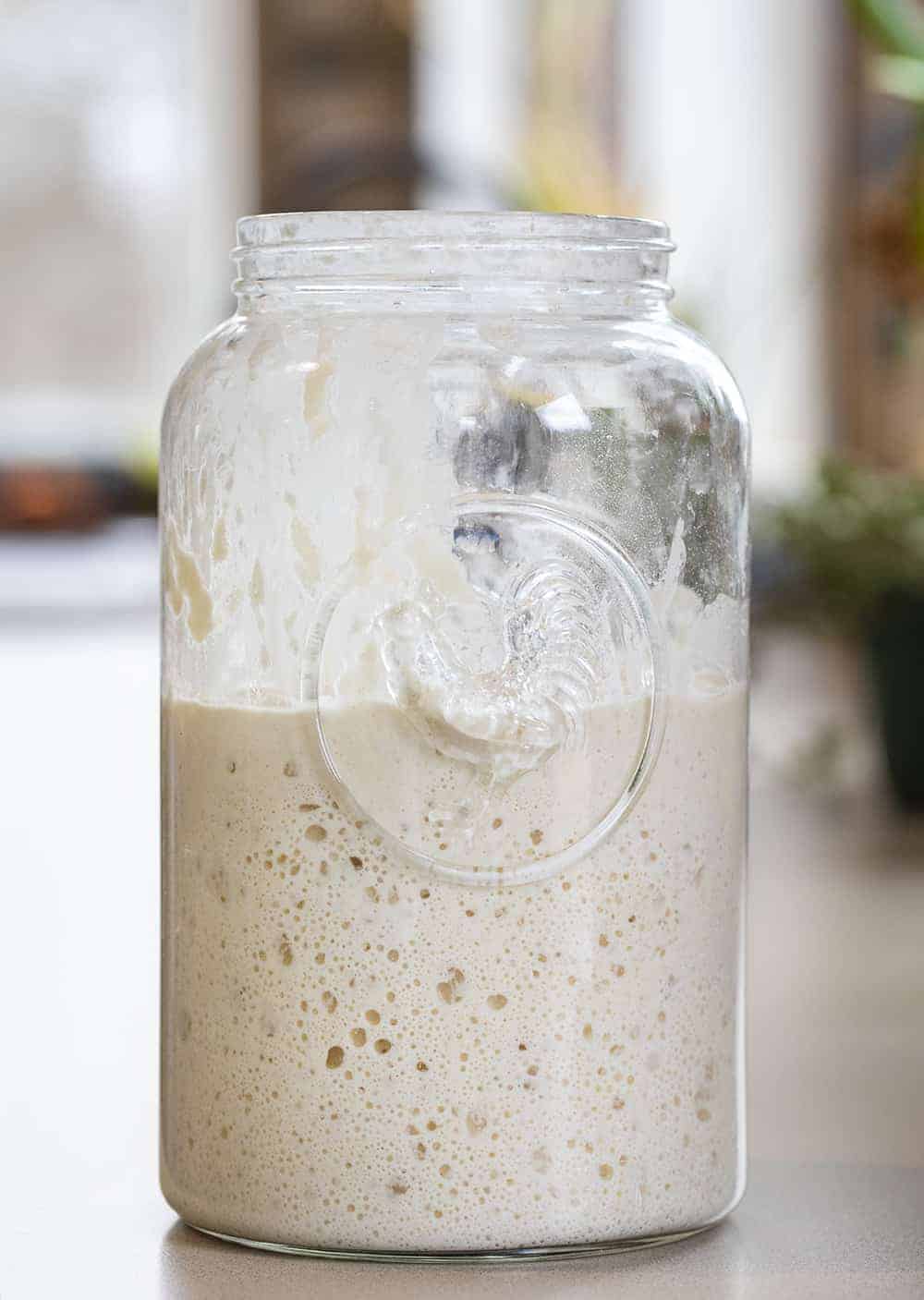
Sourdough Starter
I have to start out by saying that this is how *I* do a starter. I have watched every expert under the sun and read every book and let me tell you something… they are all different. So I have been testing and testing and retesting and using life experience to determine what works best for me. Well, I finally decided on what worked best for me, and it could not be easier and straight forward. The ingredients are simple: flour and water. And, with just two measurements to remember, the feeding is a piece of cake (or should I say bread😉) as well!
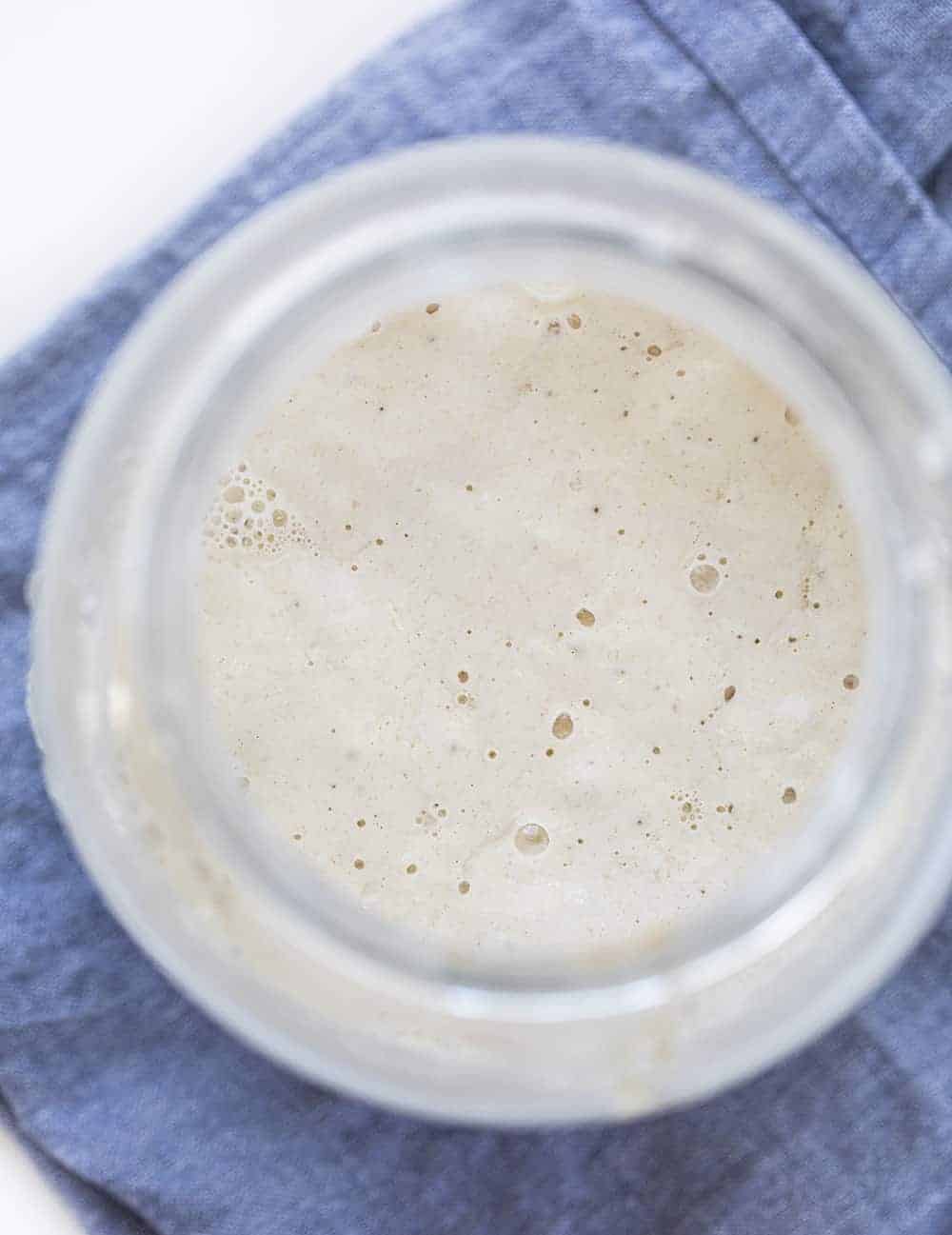
Getting your Sourdough Starter Started
Now if you want to bring science into it, the type of flour and type of water you use are important. They can produce a better product. But I am here to tell you that you can absolutely use all-purpose bleached flour from Dollar General and it will still be ok. Make sure you have the following materials and ingredients on hand:
- Jar & Lid – I prefer glass, you don’t want to use metal or plastic. If you don’t have a lid use a paper towel and rubber band. A good size jar to have on hand for a sourdough starter is a quart (32 ounces) or something close to that capacity.
- Flour – I prefer organic unbleached all-purpose, but also love whole-wheat and bread flour. Or, give rye flour a try.
- Water -Purified is best. Have chlorinated tap water (as most people do)? You can use bottled water or just set the water out uncovered for 24 hours before using it to feed your starter. This allows the chlorine to evaporate so it won’t kill the wild yeast.
That’s it for supplies! Now, let’s get to making the starter.
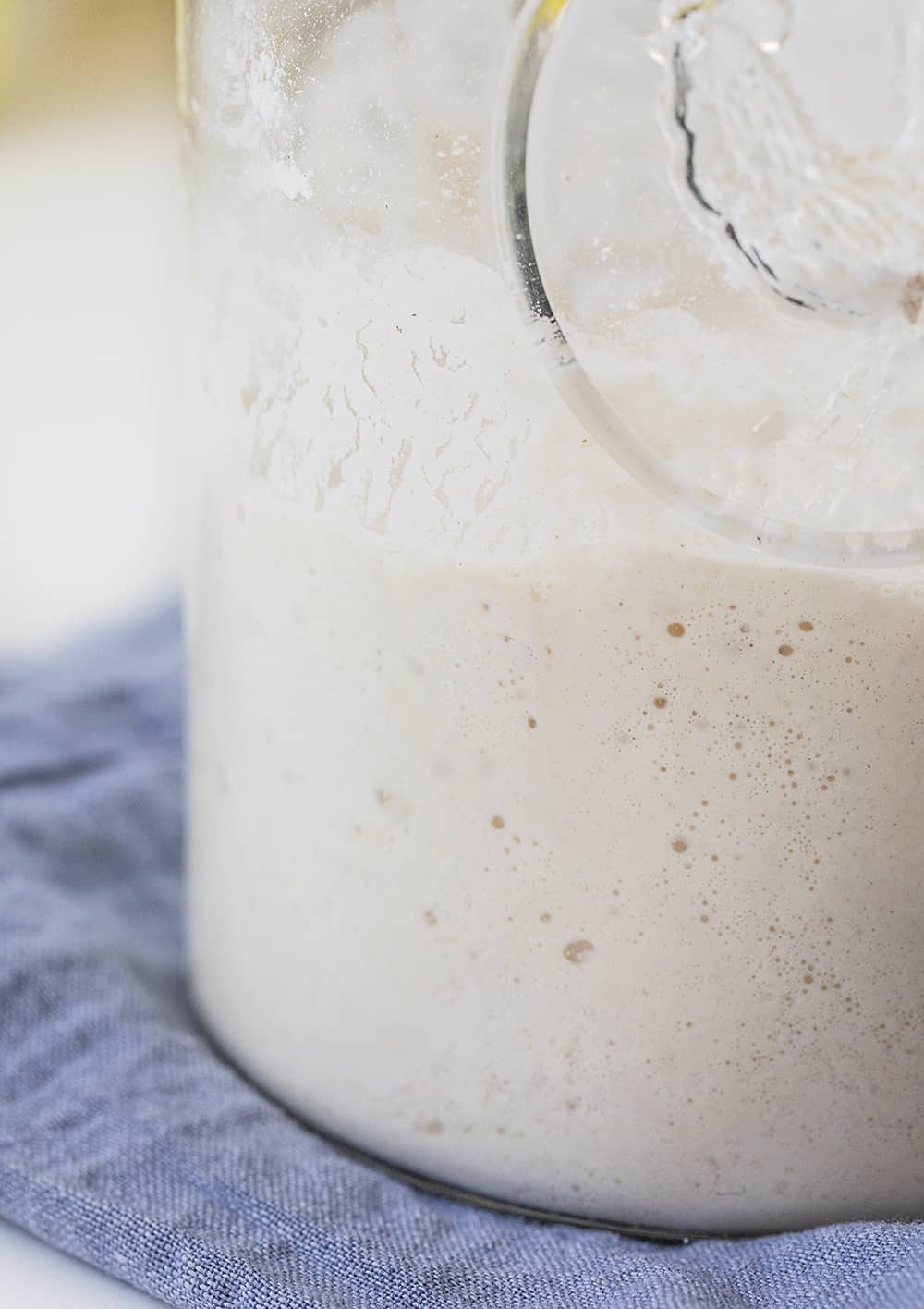
How to Make a Sourdough Starter
Remember these amounts: 1/2 cup flour and 1/4-1/3 cup water. These are the only measurements you will need to remember throughout this entire process of creating your sourdough starter. And trust me, you will use those measurements a lot with all the ‘feeding’, going on! After all, the goal is to get those microorganisms to work for that sour and fermented flavor that sourdough is known for.
To begin, add the flour and water to a jar and stir well. Try not to use a metal spoon. After all, Grandma said she always uses the handle of her wooden spoon to stir. Now gently cover the jar (do not seal it closed) and let it sit in a warm place (70°F is best) for 24 hours. The best option for a cover is a paper towel and rubber band. Or, just remember to keep the jar lid loosely sealed. Try to keep it in an area of your house that is somewhat warm. Very cool rooms tend to slow the action of a starter. Wait 24 hours before checking the mixture.
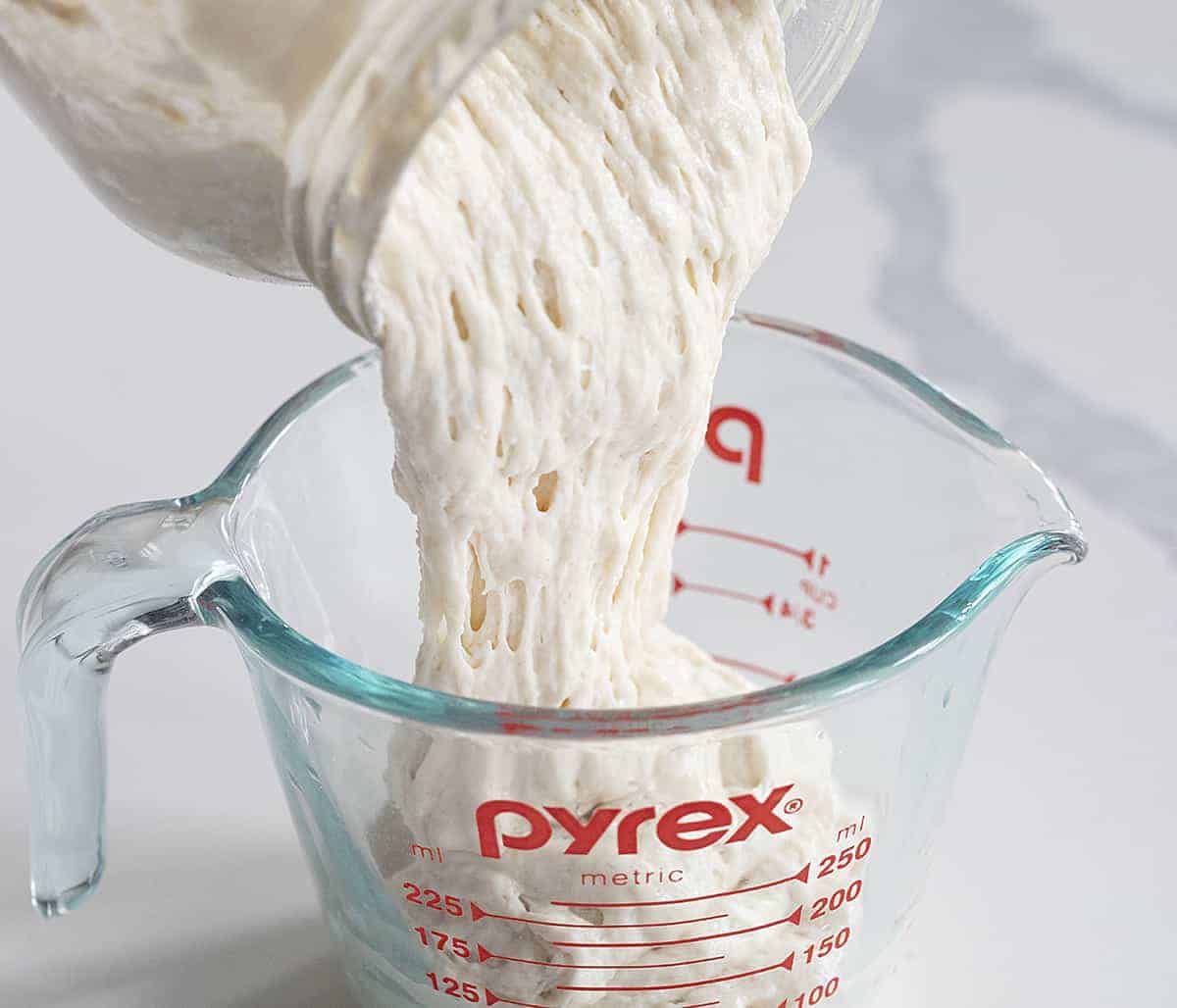
‘Feeding’ the Sourdough Starter
With sourdough starters, you will hear the term ‘feeding’. This is simply adding the flour and water to the mixture to keep the microorganisms working. Remember the measurements I told you to get ingrained in your brain? The 1/2 cup flour and 1/4-1/3 cup water is all you will need throughout the ‘feeding’ process.
Day 2: After 24 hours, check the mixture for bubbles. If you see bubbles, add the flour and the water, mixing it well, and let it sit for the next 24 hours. If you don’t see bubbles, do not get discouraged! It sometimes takes a couple of days for the science of it all to work. Just wait another day (or even two) until the first feeding.
Day 3: After another 24 hours, check for bubbles. If you do see bubbles, remove half of the starter, add the 1⁄2 cup flour and 1⁄4-1/3 cup water and stir thoroughly. Let sit 24 hours. Oh, and don’t get rid of the starter you removed! I will give you some ideas on how to use this in the end.
For the third feeding, remove half of the starter (but don’t throw it out!), and feed with 1⁄2 cup and 1⁄4 cup water, stirring thoroughly. Let sit 24 hours. (And yes, you can begin a new starter with the discard! Try adding a new kind of four! Or simply use to make crackers or pancakes.)
On days 4, 5, 6 you can feed it 2 times a day with those measurements that are sure to be memorized at this point😀. Continue this routine (discarding before feeding) until the starter is consistently bubbling and doubling in size within 8 hours of each feeding.
It is now ready to use for a perfect Sourdough Bread!
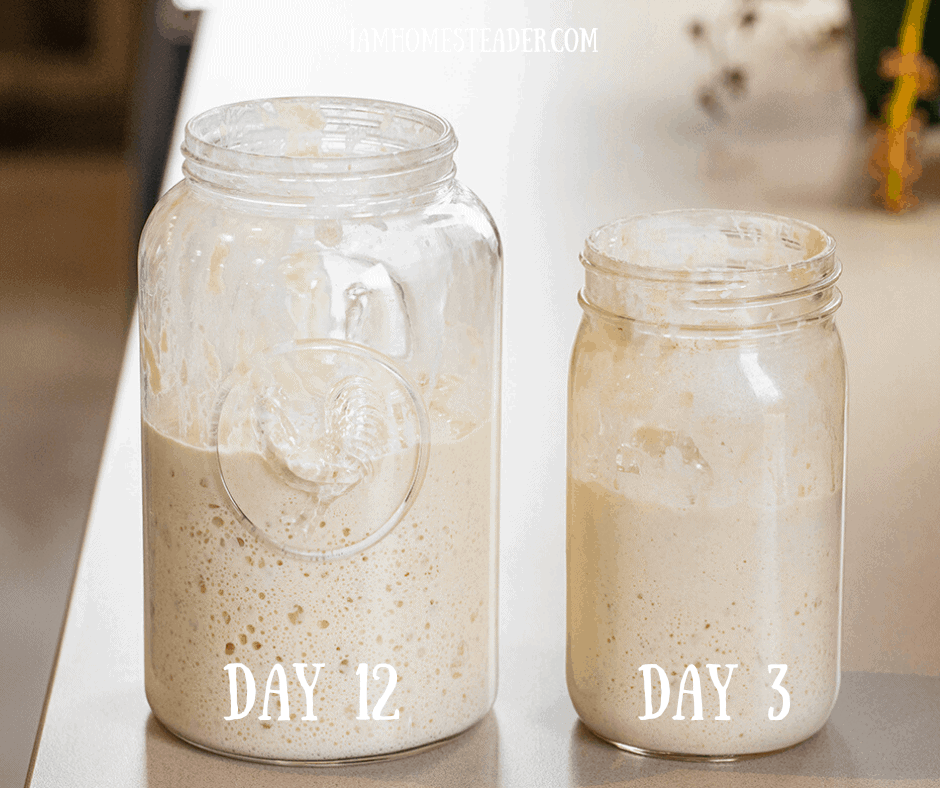
How to Store a Sourdough Starter
After all the feeding and you know you have a strong, active starter, you can store the starter in the refrigerator and feed it about once per week. When you plan to use the starter, pull it out of the refrigerator 24 hours in advance to feed it and allow it to warm up and grow.
These starters get better with age, so don’t think you have to use it right away! Sourdough starters are hearty, so they last quite a while. But, like all living things, it can get ‘sick’ or go bad. If it turns pink, red, moldy, or gets a really putrid smell, throw it out. After all, you now know how to start again!
What Flours Can You Use in a Sourdough Starter?
All grain-based flours will work beautifully in a starter. A few examples are:
- Rye
- Bread Flour
- Rice
- Whole Wheat
- Einkorn
Truesourdough.com has a great comprehensive guide to flours.
Vanilla and Bean has a great guide to Gluten-Free sourdough starter.
What to do with the Discard?
As I said, don’t throw out the sourdough starter that you remove each feeding time to make room for the starter to rise. Just make sure your sourdough starter is room temperature (about 70°F) before using it in baking. Here are some ideas on how to use (and enjoy) the excess sourdough starter.
- Sourdough Bread (not until day 6 or 7)
- Sourdough Pancakes (seriously SO GOOD!)
- Sourdough English Muffins
- Sourdough Brownies
- Sourdough Pretzels
- Cinnamon Rolls (the best!)
- Banana Bread
- Sourdough Crackers (like saltines)
- Sourdough Chocolate Chip Cookies
- Sourdough Pasta Noodles
As I mentioned, this is how *I* make a starter. King Arthur recommends 1 cup flour and 1/2 cup water and they suggest you weigh ingredients with a scale. (This is the same equivalent that I use, just doubled.) Pro Home Cooks has a great free downloadable Sourdough guide for those who really want to understand the science behind it.
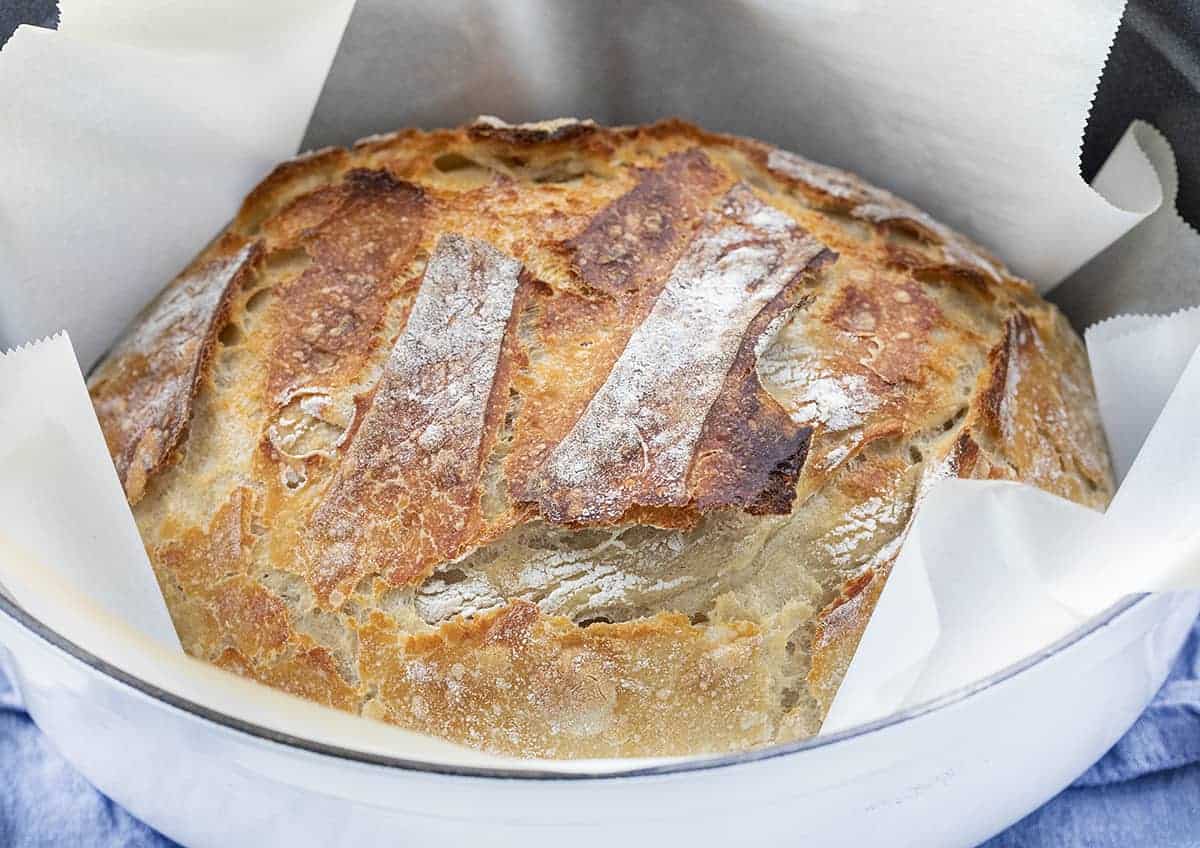
Here is the recipe for Simple Sourdough Bread!
More Sourdough Recipes
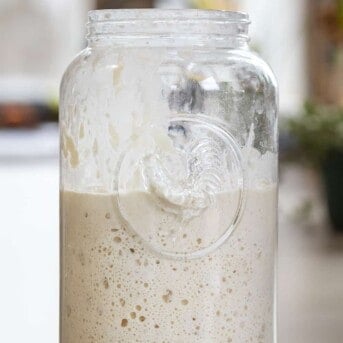
Sourdough Starter
Ingredients
- ½ cup flour, whole wheat or unbleached all-purpose
- ¼-⅓ cup water*, 75°F is ideal
- 1 glass jar, or bowl (about 32 ounces)
- 1 paper towel
- 1 rubber band
Instructions
TO BEGIN
- Start the process by adding ½ cup whole wheat flour and ¼ cup water to the jar. (If you need more flour to reach a pancake batter consistency, you can add up to ¼ cup more.) After letting it rest for 30 minutes, stir the mix with a wooden spoon. Set aside until the first feeding.
THE FIRST FEEDING
- Stir thoroughly and cover with a towel and rubber band. Let sit for 24 hours at room temperature. (Try to keep it in an area of your house that is somewhat warm. Very cool rooms tend to slow the action of a starter.)
- After 24 hours, check the mixture for bubbles. If you see some, add ½ cup all-purpose flour and ¼-⅓cup water. If you don’t see bubbles, give it a stir and let sit 24 more hours.
THE SECOND FEEDING
- Check for bubbles again. If you do see bubbles, remove half of the starter, add ½ cup all-purpose flour and ¼-⅓ cup water and stir thoroughly. Let sit 24 hours.
THE THIRD FEEDING
- Remove half of the starter, and feed with ½ cup all-purpose flour and ¼ cup water, stirring thoroughly. Let sit 24 hours.
ADDITIONAL FEEDINGS
- On days 4, 5, 6 you can feed it 2 times a day, if you want and plan on using it.
- Continue this routine until the starter is consistently bubbling and doubling in size within 8 hours of each feeding.
- From this point (or even on day 5), you can store the starter in the refrigerator and feed it about once per week. When you plan to use the starter, pull it out of the refrigerator 24 hours in advance to feed it and allow it to warm up and grow.
Video
Notes
Did you make this recipe?
You can tag me at @iamhomesteader.
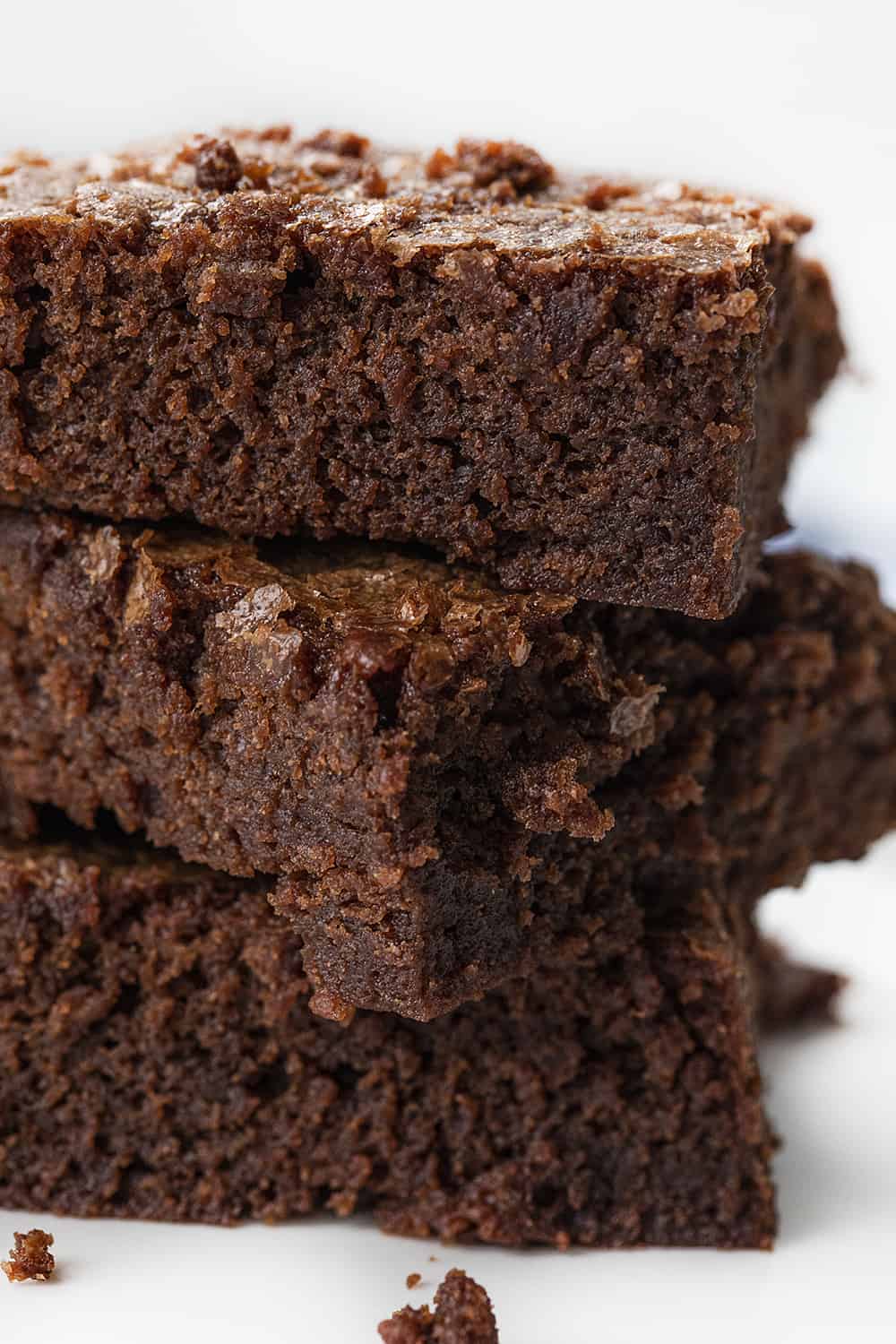
I used this starter to make seriously decadent Chocolate Sourdough Brownies!

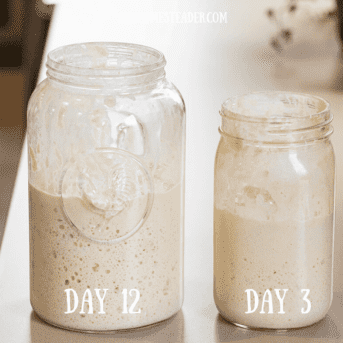
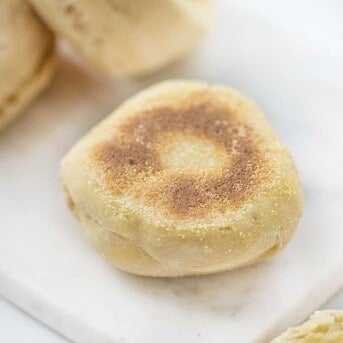
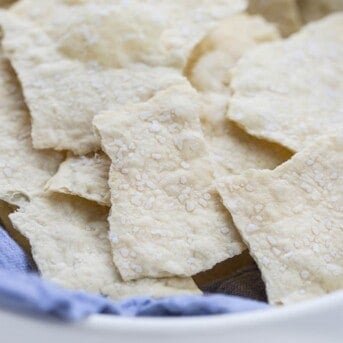
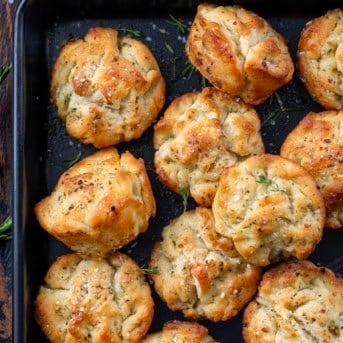


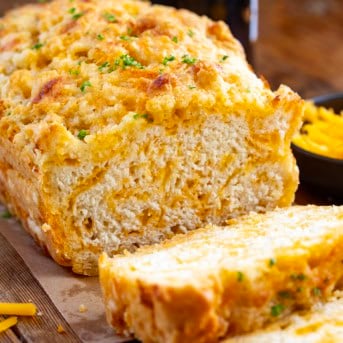
Hi Amanda,
I have completed my sourdough starter and it is now in the fridge.
When I go to feed it once a week, do I take it out and let it get to room temperature first? Also when i feed it do i have to discard half of it before feeding it? Do i only give it the 1/2 cup flour and 1/3 cup water ratio?
Thank you for your help.
Hi Darlene!
After you have established your starter and have refrigerated it, take it out once a week and drain off any excess liquid. (If there is any) Remove half (you will want at least 1/2 cup to remain) then FEED IT! (cold). I like to use warm water when feeding. Mix and then let it sit on the counter (70°F) for an hour or two to help the feeding. Then pop it back into the fridge.
Hi Amanda, Thanks for your blog. I was excited to see this as I’ve used sour dough in the past, but I have to stay gluten free for right now so I started with 1/4 cup of GF flour and about that much water. I fed same amounts on the first day and on the third day when I went to remove 1/2 of the starter, I found some gray globs in the batter. It didn’t smell bad; but I threw the whole thing out. Any helpful hints you might have? Thanks for your help! 🙂
Oh goodness! That happened to me once and I threw it out as well. I would start over (hopefully you have already) with the same flour and just make sure it’s at a constant temp. (Our home ranges from 60-70 so I move it around to keep it warm.). Good luck!! I have a feeling it will work this time! <3
On days 4-6, do you DISCARD before feeding or just feed twice daily?
Discard before feeding! 🙂
Day 4 my starter has soft crust on top. I keep it inside the oven with light on. Do you know what caused the crusty top?
Hi Amanda! I’m on Day 3, going strong. I’m wondering about combining discards. Tomorrow, when I feed twice, can I combine the discards from each feeding to bake something with that night? That is to say, as long as they’re from the same day, is it ok to combine the discards? I’m just thinking I won’t have enough for the discard recipe I want to use.
Also, I made another starter from Day 3’s discard, just to see how each one does. Since these 2 are on the same schedule, could I combine discards from BOTH?
Thanks so much!!
Yes! You can absolutely combine discards! I actually made sourdough bread with my day 7 discards and it was fabulous! And yes, you can combine the 2 different discards. I have fed discards if I know I am baking in the evening just to make sure they are happy before I use them up. 🙂
I am on day four and have noticed that most sourdough “discard” recipes call for 1c. of starter. If I discard half of my starter before feeding, it measures out to be 1/2c. How do I get 1c. of starter without using the entire thing? Thanks!
You can feed your discard! 🙂
Hi Amanda
On day 4 when I feed it twice do I also discard twice.
Thank you
Deirdre from Toronto
Quick question: tried reading through to see if anyone asked this already but didn’t see. The “discard” which is just half of the starter; can you use that as a 2nd starter? Or am I missing something?
Actually, I see the answer now! Thanks!
On day 4-6 you say to feed the starter. Do you also take out part of it as you did on days 1-3?
No, you are not discarding until day 3
Day 4 and mine still smells good but there is liquid and no bubbles, can I drain off liquid and feed to revive or should I start over
thank you
Yes, I would drain it off and try adding more flour. Stir, then see how much more moisture it can take before turning into the pancake batter consistency!
Hi and thank you for the video, very informative . I just wanted to ask if you start with one kind of flour, so you need to continue with the same flour or can it be changed. Also can it be done with a spelt flour. And do your recipes tell you how much starter you add in your recipes
Thanks you from Australia
Most experts do not recommend changing flours, they say you should stick to the same flour that you started with. However, I started one with an AP flour then changed it to have bread flour about 6 days in and it thrived.
Hi there.
I’m up to day 5 and the weather has gotten colder. My starter has got a bit of liquid on the top and smells like vinegar today. What does that mean? Is it still ok? It’s been going great up until this cold day. I’ve read through all the comments and couldn’t find anyone else with this.
I would pour the liquid off and then feed it, but add a little less water than you did previously. If you are on day 5 you can feed this 2x a day, and it should be perfect by tomorrow!
I forgot to feed mine on day 2. 🙁 Googled it and as directed I poured off excess liquid and fed it 1/2 C flour and 1/4 C water. I hope that is right! I set alarms on my phone so I don’t forget again!
Do I remove 1/2 the starter for every feeding?
Thanks so much! Excited to try crackers and br browniea as well as the bread!
I actually don’t discard until day 3, but if it is going well for you then stick to what works! 🙂 So yes, you remove before feeding moving forward.
When your starter is ready to use. The amount you take out to make your bread do you add the same amount back into the bark with the water.
Thank you
Deirdre
Mine does not small like yeast! Put some in biscuits I didn’t like the taste. Throwing out, starting over. Thanks for recipe!
It should start to smell on day 3, more and more strong as you go. I wouldn’t throw it out just yet! Remove some, discard that, and feed it. I bet it will come back to life!
I can’t wait to try this but when I start taking out half do I have to use it right away or can I add more discard
When you start taking some out on Day 3 or 4 you can use that or throw it. Yes, you continue feeding those days, and maybe even feeding twice a day.
I loved watching your video, can we be friends ? 😃
Question, what brand of Dutch Oven do you have?
Ha! Thanks! It is a Staub.
Amamda
Think you, I’m from Ca and grew up with San Francisco sour dough!
I’m now living in rural Oklahoma , I’m missing my sour dough, and sourdough English muffins, not to mention sourdough and still cut oaks pancakes 😋. I will be using your sourdough recipe and I sure appreciate you.
Diane Waltman
I am on day 3 of the starter- When I went to check it after noticing that it had filled about half the jar, it had completely fallen. Does that mean something? Do I continue?
That just means it was hungry and not fed fast enough. If your sourdough is thriving (sounds like yours is) you can feed it 2 times a day.
When we are ready to store start in fridge which is best a regular lid or the paper towel and rubber band? I am assuming the regular quart jar lid. Won’t the starter dry out with paper towel?
Thank you for sharing this recipe Amanda. I am on day 3 so later today I will remove half the starter and feed it. Can I use the removed starter right away? Also if I keep a starter in the fridge, should I let it sit out before feeding or can I feed right away once I take it out of fridge?
You can use day 3 discard for easy things like waffles and pancakes! I wouldn’t make sourdough bread until day 6-7. Glad your starter is going strong!
If I start with all purpose can I feed with wheat? And switch back and forth?
It depends on how well you want to “know” your starter. Each flour has a distinct flavor and odor and delivers different flavors in bread. If you don’t mind a hybrid then I would go ahead and mix. I have mixed all-purpose and wheat flour with success, but have not tried any other variations.
On days 4-6..I an taking out half at both the feedings ??